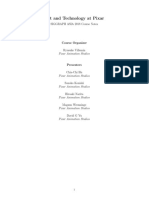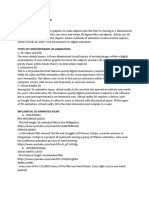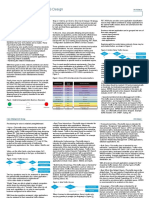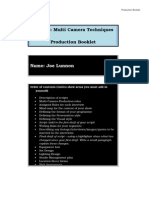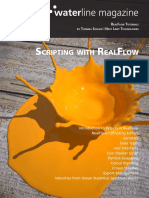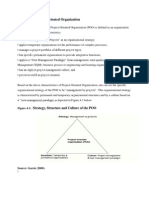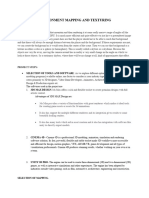Visual Effects Pipeline - VFX
Visual Effects Pipeline - VFX
Uploaded by
sam rehmanCopyright:
Available Formats
Visual Effects Pipeline - VFX
Visual Effects Pipeline - VFX
Uploaded by
sam rehmanOriginal Title
Copyright
Available Formats
Share this document
Did you find this document useful?
Is this content inappropriate?
Copyright:
Available Formats
Visual Effects Pipeline - VFX
Visual Effects Pipeline - VFX
Uploaded by
sam rehmanCopyright:
Available Formats
Goutam Banerjee
9831631949
What is the Visual Effects Pipeline?
The VFX pipeline refers to the various stages of production required to add visual
effects to a film. The pipeline helps to organize each department, so that every artist
knows their role, and a production can move along within the allocated timeline.
If you want to work as a VFX artist, you need to understand every step of the visual
effects pipeline. Wherever your role sits within the pipeline, you must be familiar with
every department's purpose in order to create the best and most efficient work. If your
work is not completed with each step of the pipeline in mind, it can cause problems
down the line and be sent back to you for redoing. This is costly and can hold up the
process!
Before we start, it's helpful to know that a film project is generally divided into 3 stages:
Pre-production: The idea for a film is developed, scripts are written (and re-written!),
budgets and timelines are determined, financing is secured, actors and locations
are sourced.
Production: The filming takes place on set (can be on location, or in a studio with
sets and/or green screens).
Post-production: Visual effects are applied to the footage, sound, editing and color
grading take place, and the film is ready for distribution.
While the VFX pipeline touches each stage of the filmmaking process, the majority of VFX
work happens in post-production (or, 'post' for short). Let's dive into 10 steps of the VFX
pipeline:
1. Story
The story is the foundation of every great film. The story phase happens in pre-production and it
involves planning out characters, the plot, and the world they exist in. Screenwriters and
producers take ideas from brainstorming sessions, turning them into a complete script. If a book
is being made into a film, a screenwriter may be hired to adapt the story so that it translates well
on screen. Some examples of this include Lord of the Rings and Harry Potter. If you want to get
experience writing scripts, we recommend starting with Celtx, as it is free and has auto-
formatting.
2. Storyboarding and Animatics
During the Storyboarding & Animatics phase, an artist or team of artists create visual
representations of the actions within the script. They analyze the character motion and settings
within the story and use basic drawings to define framing from shot to shot. The results are
subject to change down the line, but these visuals give the production team a chance to start
preparing.
Goutam Banerjee
9831631949
3. Pre-Vis
Growing more popular, pre-vis takes storyboarding a step further. 3D artists create low poly
models and representations of the locations where scenes play out. They work with the
production team to set up camera angles and block out complex scenes ahead of time. This
planning saves time and money on set. Since the artists don’t have to worry about matching
concept art, but just blocking out shapes and composition, this can be done rather quickly with
good direction.
4. Concept Art and Design
Concept art & design is arguably one of the most important phases of pre-production. Here, an
artist or team of artists create the look and feel of a film by drawing fully fleshed out images that
further define settings, characters, props, costumes, lighting, color and more. The mood and
meaning of a film is often defined by what is created during the concept art phase.
5. Layout and Production Design
Layout, also referred to as production design, has a different meaning for different teams. The
end goal is to have a visual representation of what the final sets will look like. This helps
physical set builders figure out and communicate to directors and producers what is physically
possible and what may need a digital set build. For the VFX team, it defines how digital set
builds might have to be incorporated. The layout team and production designers may use
drawings, photos, and 3D renderings to finalize the sets.
6. Research and Development (or, R&D)
As filmmaking gets more complex, R&D becomes increasingly more important. During this
stage, VFX supervisors work with directors to figure out how certain shots can be accomplished.
In the meantime, the VFX artists, technical directors, modelers, animators, and compositors do
their own research. For example, if a film needs explosions that come from a very specific type
of source, like a missile, the VFX artists and technical directors study videos and photos to see
how the fire and smoke behaves. They then create tools within a program to efficiently work on
the final shots when the time comes.
7. 3D Modeling & Texturing
The 3D modeling and texturing teams are essential to creating things that aren’t practical or cost-
effective to have on set. Being one of the first groups involved in the post-production process,
they may have to model assets such as props, buildings, vehicles, and weapons to fulfil the
director's vision. 3D models may also be used to complement something shot on set. If an actor
Goutam Banerjee
9831631949
like Andy Serkis is shot in a motion capture suit, a 3D Modeler would create the character he is
playing. This model is then rigged and animated. 3D Modelers generally use software
like Autodesk Maya and Pixologic ZBrush. Texture artists use digital painting programs like The
Foundry’s Mari.
To learn more about Modeling and Texturing see: What is 3D Modeling? and What is 3D Texturing?
What is 3D modeling?
3D modeling is the creation of a computer-generated representation of an object or character in
3D space.
A 3D Modeler has to build models before they can be animated or VFX can be applied.
Depending on the end goal, they may be working from scratch, concept art, other 3D designs or
even optimizing scan data to create models. A Modeler might also work on the topology, or the
way vertices and edges are arranged, to ensure the model is ready for the next steps in the
pipeline.
Successful modelers have creative ways of getting the job done in the time allotted while
ensuring the accuracy of the final product.
Models are used in almost every type of TV show, movie, game and VR app. In movies like The
Incredible Hulk, modelers were required to re-create the legendary character. In cases like this,
the precision is crucial in keeping the integrity of the original Hulk character, while creating it
with today’s amazing technology standards.
In Blizzard's hit game Overwatch, many of the characters are wearing armor. The character
modelers working on games like this have to be well versed in both hard-surface and organic
modeling.
Hard surface refers to things like spaceships, buildings, weapons, and vehicles. Whereas organic
includes characters, plants, animals, and outdoor environments etc.
What does a 3D Texture Artist do?
A 3D Texture Artist creates stylized or natural textures and materials that are then applied to 3D
models and environments in games, films, or TV shows. They play an important role in the VFX
Pipeline.
Whether texturing game models or film assets, Texture Artists use a variety of texturing software
and techniques. They may use Photoshop or Mari to paint high resolution image textures or use
scanned-in 3D data; or build procedural materials (a network of properties that can be changed
fairly easily) in a program like Substance Designer (see video below for examples).
8. Rigging and Animation
Before an object or character can be animated, a rigging team must build a system of controls, or
a digital skeleton, for the Animator to use. This usually involves adding bones, calculating and
implementing skin weights, and adding muscles to create natural movement. The Animator uses
Goutam Banerjee
9831631949
the custom controls of the rig to bring the character, prop, or vehicle to life. Nowadays, an
Animator may also be working with motion capture data. Motion capture data often needs to be
tweaked to achieve a final look, and an experienced Animator is essential. 3D animation for a
feature film is often done in Autodesk Maya.
8. FX & Simulation
The job of an FX artist revolves around adding simulated elements to a film that seamlessly exist
in the director’s world. At any given time, an FX artist could be working on things like
destruction, fire, liquids, smoke, and particle simulations. They will often work alongside the
animators to ensure natural movement of colliding FX elements. Effects artists often use SideFX
Houdini to create mind-blowing visuals in blockbuster films.
9. Lighting and Rendering
Once the animation and effects teams are done working their magic, the 3D elements need to
have proper lighting to exist within their respective scenes. A lighting artist, or multiple lighting
artists, strategically place lights throughout the 3D scene to ensure light color, intensity, and
shadows match up with the originally shot piece. Each sequence of frames is then rendered out
from the needed camera angles and handed off to the compositor.
. 10. Compositing
This is the final step of the visual effects pipeline. A compositor takes all the elements of the film
and layers them on top of each other. They use elements like color correction, masking and other
tricks to create the illusion that all elements naturally belong together. They may be putting an
animated character into a live action scene, overlaying destruction onto a building, or even
layering a simulated tsunami over a shot of a city street. The possibilities of what a compositor
may be working on are endless, and they are often using the complex tools within The Foundry’s
Nuke to complete their work.
You might also like
- Giraffe™ Shuttle: Service ManualDocument162 pagesGiraffe™ Shuttle: Service ManualRajasekhar ReddyNo ratings yet
- ILM Recruitment GuideDocument8 pagesILM Recruitment GuideHafiz AnuarNo ratings yet
- Introduction To The Universal Render Pipeline For Advanced Unity Creators 2024Document140 pagesIntroduction To The Universal Render Pipeline For Advanced Unity Creators 2024nahhhfelixNo ratings yet
- Foundations: Computers, Technology and Security: GfactDocument2 pagesFoundations: Computers, Technology and Security: Gfactafomin0118No ratings yet
- 3D World - Issue 309, 2024 UKDocument100 pages3D World - Issue 309, 2024 UKambrus.zoltan77100% (1)
- Writing For The ScreenDocument9 pagesWriting For The Screensam rehmanNo ratings yet
- The Visual Effects Production PipeLineDocument32 pagesThe Visual Effects Production PipeLinesanogkNo ratings yet
- MSC Thesis: Crowd Simulation Implementation in Houdini FX Using Custom VEX OperatorsDocument36 pagesMSC Thesis: Crowd Simulation Implementation in Houdini FX Using Custom VEX OperatorsNomish BhardwajNo ratings yet
- Beginning C - Through Game Prog - Michael DawsonDocument11 pagesBeginning C - Through Game Prog - Michael DawsonEdwin BerriosNo ratings yet
- Hydra Pixar Presentation S5327-Jeremy-CowlesDocument23 pagesHydra Pixar Presentation S5327-Jeremy-CowlesrendermanuserNo ratings yet
- Modo 601: Warner McgeeDocument54 pagesModo 601: Warner McgeeAuren7No ratings yet
- SMA ESA WSA - Compatibility PDFDocument77 pagesSMA ESA WSA - Compatibility PDFdhazh007No ratings yet
- 3D Animation Production - Step by StepDocument1 page3D Animation Production - Step by StepSITI IZANI BINTI IDRIS (PTSS)No ratings yet
- Art and Technology Today at Pixar Part 2Document68 pagesArt and Technology Today at Pixar Part 2MateoNo ratings yet
- Wireframes Prototypes Comp PDFDocument20 pagesWireframes Prototypes Comp PDFarjunmba119624No ratings yet
- 3D AnimationDocument4 pages3D AnimationalokvvitNo ratings yet
- 3d Modelling and Animation SystemsDocument31 pages3d Modelling and Animation SystemsSukriadi ShafarNo ratings yet
- Computer Animation Project ProposalDocument4 pagesComputer Animation Project ProposalJobertsonNo ratings yet
- Lean UX For StartupsDocument9 pagesLean UX For Startupskastiel73No ratings yet
- Adopting Virtual Production For Animated PDFDocument8 pagesAdopting Virtual Production For Animated PDFhladnopivoNo ratings yet
- Topic 3 (5) - AnimationDocument39 pagesTopic 3 (5) - AnimationUmi NadzirahNo ratings yet
- Cyber+Magazine+ +june+2024Document196 pagesCyber+Magazine+ +june+2024matlnx100% (1)
- History of 3D Animation Brief ExplanationDocument2 pagesHistory of 3D Animation Brief ExplanationAvery VillaNo ratings yet
- 01 Cisco Strategic QoS Design AAGDocument2 pages01 Cisco Strategic QoS Design AAGpaulo_an7381No ratings yet
- AI GamesDocument7 pagesAI Gamesengineer_khaula7035No ratings yet
- Aotc Autodesk 3ds Max 9 Maxscript Essential - UnlockedDocument5 pagesAotc Autodesk 3ds Max 9 Maxscript Essential - UnlockedjasopanevNo ratings yet
- Studio Production BookletDocument22 pagesStudio Production Bookletapi-264079956No ratings yet
- Togaf Ea MethodologyDocument27 pagesTogaf Ea MethodologyWei KaideNo ratings yet
- MYP Unit Planner - Tilted VersionDocument9 pagesMYP Unit Planner - Tilted VersionkolawoleNo ratings yet
- The Future of Virtual Reality For Amusement IndustryDocument11 pagesThe Future of Virtual Reality For Amusement IndustryBob CooneyNo ratings yet
- 3d Artist New CVDocument1 page3d Artist New CVMustafa HashmyNo ratings yet
- Improvement of User Experience Using Virtual Reality in Open-Architecture Product DesignDocument12 pagesImprovement of User Experience Using Virtual Reality in Open-Architecture Product DesignJonas AssisNo ratings yet
- Modelling GuidelinesDocument194 pagesModelling GuidelinesSyl Vain Riss100% (1)
- Houdini Foundation OverviewDocument50 pagesHoudini Foundation OverviewPlanemoNo ratings yet
- Intro To AnimationDocument18 pagesIntro To AnimationJepski M. LocardoNo ratings yet
- C++ in Embedded Systems - Myth and RealityDocument9 pagesC++ in Embedded Systems - Myth and RealityTruong Phong TuyenNo ratings yet
- 5035get Patterns of Strategy 1st Edition Patrick Hoverstadt Free All ChaptersDocument84 pages5035get Patterns of Strategy 1st Edition Patrick Hoverstadt Free All Chaptersnakalleydon100% (7)
- 2d Studio PlanDocument1 page2d Studio Plan18011BC031 charanNo ratings yet
- ESXi ArchitectureDocument10 pagesESXi Architecturegxa2007No ratings yet
- Waterline Real Flow ScriptingDocument98 pagesWaterline Real Flow Scripting0zog3766100% (1)
- SpriteKit PGDocument99 pagesSpriteKit PGjose cegri100% (1)
- VP Field Guide Vol 1 and 2Document256 pagesVP Field Guide Vol 1 and 2AntonioNo ratings yet
- Brochure Motion Graphic DesignDocument12 pagesBrochure Motion Graphic DesignKing Gamer BROTODIPNo ratings yet
- Handbook of Industrial Polyethylene and Technology Definitive Guide to Manufacturing Properties Processing Applications and Markets Spalding Mark A. (Ed.) all chapter instant downloadDocument52 pagesHandbook of Industrial Polyethylene and Technology Definitive Guide to Manufacturing Properties Processing Applications and Markets Spalding Mark A. (Ed.) all chapter instant downloadkefllasabol100% (2)
- 3D City Modeling - ProjectDocument62 pages3D City Modeling - ProjectMohammed ElzainNo ratings yet
- PooDocument8 pagesPoowalabuNo ratings yet
- UML Diagramming Guide 5.0Document102 pagesUML Diagramming Guide 5.0Gopi Jampani100% (2)
- Unreal EngineDocument40 pagesUnreal EngineReam FahdiNo ratings yet
- Freefincal Stock Analyzer May 2017 SCR Edition Earnings Power Box 1Document1,257 pagesFreefincal Stock Analyzer May 2017 SCR Edition Earnings Power Box 1Positive ThinkerNo ratings yet
- Staggered Animation in 3D: Exercise PreviewDocument5 pagesStaggered Animation in 3D: Exercise PreviewplhoangvietNo ratings yet
- KUBERNETES A Simple Guide To Master Kubernetes For Beginners and Advanced Users (2020 Edition) (Brian Docker)Document102 pagesKUBERNETES A Simple Guide To Master Kubernetes For Beginners and Advanced Users (2020 Edition) (Brian Docker)Ridwan Satrio HadikusumaNo ratings yet
- AnimationDocument16 pagesAnimationBalaji VaradharajanNo ratings yet
- Lesson 1.2 - Processes (Pipeline)Document17 pagesLesson 1.2 - Processes (Pipeline)Dennis TanjusayNo ratings yet
- VFXDocument54 pagesVFXapi-383977275% (4)
- VFX for Film and CineaticsDocument38 pagesVFX for Film and CineaticsaharitasaNo ratings yet
- Visual Effects (VFX) : IntroDocument42 pagesVisual Effects (VFX) : IntroEzzzNo ratings yet
- Notes-Unit1-3d Production Pipeline - Session1-3Document10 pagesNotes-Unit1-3d Production Pipeline - Session1-3Sana SamadNo ratings yet
- How To Make An Animated MovieDocument28 pagesHow To Make An Animated MoviePriyanka BarikNo ratings yet
- Ave - Unit 1Document12 pagesAve - Unit 1smao1No ratings yet
- Visual Effects (Commonly Shortened To Visual F/X or VFX) Are The VariousDocument9 pagesVisual Effects (Commonly Shortened To Visual F/X or VFX) Are The VariousvaparajNo ratings yet
- Animation CareerguideDocument18 pagesAnimation CareerguideMuhammad AkmalNo ratings yet
- Untitled PresentationDocument29 pagesUntitled PresentationManish VengurlekarNo ratings yet
- Environment Mapping and TexturingDocument3 pagesEnvironment Mapping and TexturingAdityaNo ratings yet
- Classical: MusicDocument49 pagesClassical: Musicsam rehmanNo ratings yet
- 001 Introduction-To-Python-Programming-LangguageDocument17 pages001 Introduction-To-Python-Programming-Langguagesam rehmanNo ratings yet
- Format Major ProjectDocument14 pagesFormat Major Projectsam rehmanNo ratings yet
- 二 kanji worksheetDocument1 page二 kanji worksheetsam rehmanNo ratings yet
- NURBS Overview: Goutam Banerjee 9831631949Document6 pagesNURBS Overview: Goutam Banerjee 9831631949sam rehmanNo ratings yet
- Evolution of CommunicationDocument8 pagesEvolution of Communicationsam rehmanNo ratings yet
- 3D Animation - ModellingDocument4 pages3D Animation - Modellingsam rehmanNo ratings yet
- 3D Animation - NURBS - 1Document4 pages3D Animation - NURBS - 1sam rehmanNo ratings yet
- BELED Complete Brochure 190318Document11 pagesBELED Complete Brochure 190318ARPIT SINGHNo ratings yet
- Schaum's OutlinesDocument5 pagesSchaum's OutlinesBehruz Mashrequi100% (1)
- CH 10 I Grabbed The Leash of The Blind Beast - Read at WuxiaWorldEUDocument1 pageCH 10 I Grabbed The Leash of The Blind Beast - Read at WuxiaWorldEUndia6902No ratings yet
- House Building EstimateDocument6 pagesHouse Building Estimate27051977No ratings yet
- Circulator Pump Energy Rating Program: Hydraulic Institute Program Guideline ForDocument36 pagesCirculator Pump Energy Rating Program: Hydraulic Institute Program Guideline ForVivek AnandNo ratings yet
- Cadet RCT Course 1st EdDocument16 pagesCadet RCT Course 1st EdJim NgNo ratings yet
- Book Approved Yellow Book 2020 - Updated - Sept 2024 AnnexureDocument67 pagesBook Approved Yellow Book 2020 - Updated - Sept 2024 Annexurejkmehar1979No ratings yet
- 327101-C-BOD-0001, Rev.01 PDFDocument54 pages327101-C-BOD-0001, Rev.01 PDFGokulprabhuNo ratings yet
- Rle - Module For CancerDocument16 pagesRle - Module For CancerDa BondadNo ratings yet
- NCP For Case Presentation (Acute Pain, Episiotomy)Document3 pagesNCP For Case Presentation (Acute Pain, Episiotomy)Jenny Ajoc100% (2)
- Company ProfileDocument26 pagesCompany Profilerudy.adichandraNo ratings yet
- 2014 RE For Beginners PDFDocument859 pages2014 RE For Beginners PDFjopNo ratings yet
- Planning Manual Siedle In-Home Bus: Issue 2017Document45 pagesPlanning Manual Siedle In-Home Bus: Issue 2017Aeron Rodwell SerranoNo ratings yet
- Advanced Reading TaskDocument7 pagesAdvanced Reading TaskMyat Myat OoNo ratings yet
- SOUTHERN MOTORS Vs MoscosoDocument2 pagesSOUTHERN MOTORS Vs MoscosoRia Gabs50% (2)
- Levon Minassian BiographyDocument2 pagesLevon Minassian BiographyAnalía GuidaNo ratings yet
- Electrical Control PanelDocument17 pagesElectrical Control Panelarjun hugarNo ratings yet
- Module 6Document5 pagesModule 6Mi CahNo ratings yet
- Parallelism: Editing byDocument30 pagesParallelism: Editing byGenesisDaquinanNo ratings yet
- Homework 2 Solutions: A B A B BDocument5 pagesHomework 2 Solutions: A B A B BJohnnyNo ratings yet
- Present Simple Present ContinuousDocument23 pagesPresent Simple Present ContinuousAlicia DomínguezNo ratings yet
- Internal Auditor Characteristics, Internal Audit Effectiveness and Moderating Effect of Senior ManagementDocument19 pagesInternal Auditor Characteristics, Internal Audit Effectiveness and Moderating Effect of Senior ManagementThiwanka GunasekaraNo ratings yet
- Configurations Steps For Standard Costing in Sap S4 HANADocument2 pagesConfigurations Steps For Standard Costing in Sap S4 HANAakshayNo ratings yet
- FATEK - Win Pro Ladder Simulator ManualDocument10 pagesFATEK - Win Pro Ladder Simulator Manualjomisefer100% (2)
- Service Blue PrintingDocument25 pagesService Blue PrintingAbhayendra KaleNo ratings yet
- Genie GS 4390, GS5390Document35 pagesGenie GS 4390, GS5390JOHNNo ratings yet
- Project On Toothpaste - Image Profile Analysis of Leading Brand ToothpastesDocument47 pagesProject On Toothpaste - Image Profile Analysis of Leading Brand Toothpastesshah faisal68% (37)
- KL 025.5 Katakedr v0.6 enDocument231 pagesKL 025.5 Katakedr v0.6 enJason ludovic Nguema ondoNo ratings yet













